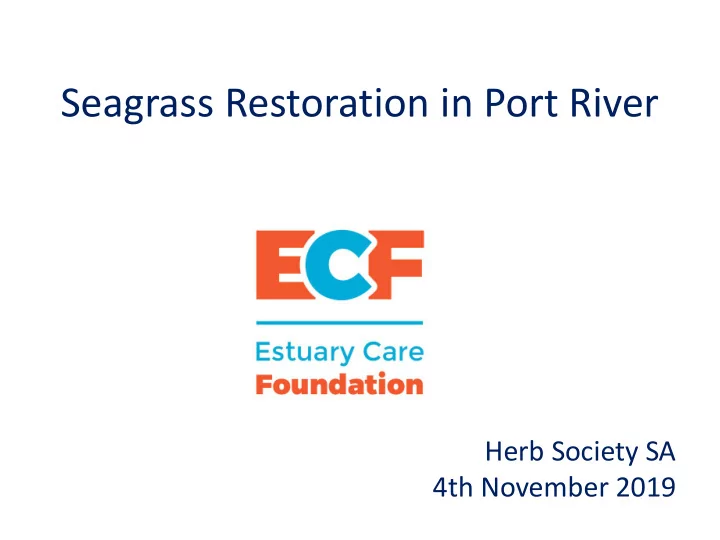

Seagrass Restoration in Port River Herb Society SA 4th November 2019
Seagrass Seagrasses are a flowering plant species Not to be confused with seaweed, which do not form flowers, fruits, and seeds to reproduce When there is abundant light, especially in summer, seagrass photosynthesis is high, and the plant will store energy
What seagrass does for us? • Nursery grounds for fish • Carbon sinks – ‘Blue Carbon’ with mangroves, samphire and shellfish reefs • Keep water clear – trap sediments and take up nutrients • Help stabile shorelines
Seagrass Restoration in Gulf St Vincent Amphibolis (wireweed): A Snorkeler’s guide to plants and animals in South Australia’s Marine Parks
Amphibolis in Gulf St Vincent • Seeds produce an anchoring comb of bristles • Form meadows on calcareous sands • Important source of food and shelter • Consolidate the substrate of the ocean floor, protecting it from erosion by currents and wave action
Seagrass Restoration in Gulf St Vincent Posidonia; photo by Dr Jason Tanner SARDI
Restoration Process • Enhance natural recruitment of Amphibolis, deploy hessian bags of sand (+) in winter • Small scale trials 2007; 2 x 1 ha trials in 2014 • Posidonia planted into the bags as seedlings by divers • 2019 - $1M for est 10 ha trials
Port River and Barker Inlet Estuary
Seagrass in Port River - Zostera Zostera in Port River August 2018; photo by Kym Murphy
Seagrass in Port River - Zostera Zostera in Port River August 2018; photos by Kym Murphy
Zostera muelleri • Southern hemisphere temperate species • Commonly referred to as eelgrass or garweed • Fast growing and readily colonising species • Feeding ground for wading birds and aquatic animals • Breeding ground for juvenile fish and shrimp species
Natural Restoration in Port River • 2010 Zostera only just south of Torrens Island Quarantine Station (Dr Tanner, SARDI) • Jan 2017 some Zostera as far south as AGL power station • Jan 2014 – closure of Penrice
Three ECF projects • Seagrass monitoring in Port River • Seagrass monitoring with AusOcean rigs • Seagrass restoration trial at Snowden’s north
Seagrass monitoring team training Garden Island, May 2018
Seagrass monitoring team training Defence Shed, May 2018
Seagrass monitoring with AusOcean
Seagrass monitoring with AusOcean
Seagrass monitoring with AusOcean Story in Advertiser & Portside Messenger, April 2019
Seagrass Restoration Trial
Seagrass Restoration - approvals • Deed of Indemnity – Flinders Ports • PIRSA Permit to Deposit Aquatic Resources – Clean recycled Pacific oyster shell from SA growers • DEW Permit to Collect Native Plant Material – Management Plan for host site
Seagrass Restoration Trial
Seagrass Restoration Trial
Seagrass Restoration Trial
Seagrass Restoration Trial Photo by Emma Daly 26.10.18
Seagrass Restoration Trial Seagrass translocation 26.10.18
Initial Results Northern site Middle site Southern site Deepest Shallowest 5 bags 6 bags 5 bags 26 Oct 2018 7 seagrass cores 7 seagrass cores 7 seagrass cores 11 Nov 2018 2 cores 3 cores 4 cores northern end southern end 9 Dec 2018 2 cores 1 core nil northern end southern end
Human impacts Bags moved, April 2019 and broken post, Oct 2019
Flinders Ports dredging Dredging completed early October 2019
Flinders Ports dredging • A Significant Environmental Benefit offset payment ($944,304.94 ) to Native Vegetation Council as compensation for the predicted loss of seagrass • Flinders Ports had approval for: – 4 hectares of direct clearance for the actual channel widening operations; and – up to 158 ha of predicted impacts associated with a winter dredge operation – from increased turbidity and sedimentation of the waters surrounding the dredge operation. • Seagrass monitoring in April 2020 and 2022
Recommend
More recommend